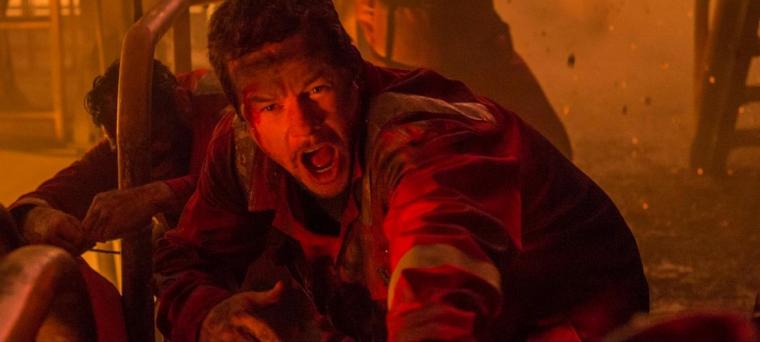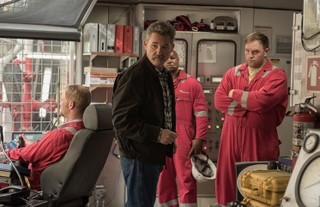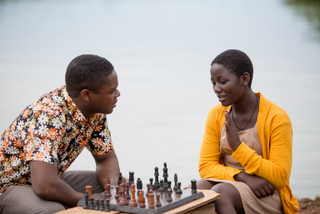
DEEPWATER HORIZON
Aside from both being based on real-life 21st Century events, you wouldn’t think that Deepwater Horizon – director Peter Berg’s disaster thriller about the devastating BP oil spill of 2010 – would have much in common with Clint Eastwood’s current “Miracle on the Hudson” hit Sully. The former finds cost-cutting recklessness leading to the deaths of 11 men; the latter details a heroic landing that resulted in zero fatalities. The horrific accident of the former lasted for months; the calamity of the latter was over in minutes. The tone of the former is tragic; the latter’s is triumphant. Yet all throughout Deepwater Horizon, and especially during its vividly detailed scenes of mass destruction, I kept thinking the same thing I thought through the whole of Sully: Why exactly was this movie even made?
In true disaster-flick fashion, Berg’s film opens on the morning that crew members board the ill-fated Deepwater Horizon rig that will wind up releasing 4.9-million barrels of oil into the Gulf of Mexico. Showing the employees as they ready themselves for work and prepare to leave their loved ones for 21 days, this quiet, warmly lit prelude is a traditional getting-to-know-you designed to build empathy for characters who will ultimately find themselves under siege. Consequently, I was more than a bit surprised when, initially, we only meet two: Mark Wahlberg’s Mike Williams, an obviously decent family man with a loving wife (Kate Hudson) and grade-school-aged daughter (Stella Allen); and Gina Rodriguez’s Andrea Fleytas, a young woman with car troubles. In due course, we also meet Kurt Russell’s grizzled rig manager “Mr. Jimmy” Harrell, see a couple of other familiar faces (Ethan Suplee, Dylan O’Brien), and are given an audience with BP executive Donald Vidrine, whom John Malkovich plays with an impenetrable New Orleans dialect and no end of Satanic glowers. (Vidrine’s minions, meanwhile, are dressed in crisp white BP polo shirts, the better to inform us that they’re Evil Incarnate.) Yet from the cast’s introductions onward, the characterizations are so sketchy that we’re not given much reason to care about anyone’s fate, and it’s not evident that Berg necessarily wants us to; despite the occasional flashes of quick, funny banter, you can sense the director antsy, really antsy, to get to the scenes of destructive pandemonium. When a drill test aboard the severely underfunded and damaged rig results in no leakage and Mr. Jimmy mutters, “We should’ve seen some mud,” it’s hard to tell if it’s his or Berg’s disappointment we’re hearing.

But hoo-boy does the mud eventually flow – arriving in tandem with terrifying fireballs, and geysers of oil and seawater, and hundreds of nuts and bolts that hurl through the air like bullets. Nearly a full half of Deepwater Horizon is dedicated to the violent catastrophe as Williams, Fleytas, and the rest attempt to minimize the damage and, when it’s apparent that the damage is irreparable, struggle to simply survive. (Even the rig’s life rafts prove to be questionable escape routes, given that the water itself is ablaze.) And Berg certainly succeeds in making this extended sequence gripping. Irwin Allen must be kicking himself in the Great Beyond for never coming up with a disaster-flick hybrid of his cheesy ’70s “classics” The Poseidon Adventure and The Towering Inferno, but in its less-schlocky, serious-minded way, that’s just what Berg has pulled off here. The nerve-racking threats of fire and water are reproduced with rather stunning realism and force, and while the director may overplay his theme of national heroism – an American flag begins popping up on-screen with suspicious frequency – it’s hard not to be moved by the life-and-death stakes. (Not to minimize the extent of the tragedy, but it’s perhaps even harder to believe that only 11 people perished given 126 crew members aboard.)
Still, isn’t there something more than a little unseemly about employing the worst ecological disaster in American history merely in service of a rather routine action thriller? It’s not like Berg and screenwriters Matthew Michael Carnahan and Matthew Sand offer extraordinary depth into just how criminally negligent BP was, the extent of the company’s responsibility restricted to a few early conversations about faulty machinery, budgetary concerns, and Malkovich’s Lucifer goatee. Meanwhile, the resulting investigations and court proceedings that found BP liable to the tune of $18.7 billion are quickly tossed off in a few end-credit updates (although Berg, in the most moving segment of the film, does pay touching individual tribute to the 11 who died). In short, as with Sully, we don’t learn anything in Deepwater Horizon that we didn’t already know through TV and newspaper coverage at the time. And despite the solid acting and superb sound and visual effects, I left feeling that the only reason the movie existed was to jazz audiences with a recent, real-life nightmare replicated with a huge Hollywood budget – and I don’t think you need to be overly sensitive to find something rather repellant about that. Just because dramatic events occur doesn’t mean they need to be dramatized.

QUEEN OF KATWE
If you’ve watched a significant number of Disney’s inspirational sports dramas, you know that many of them, even/especially the most cornball ones, can get you weepy. And if you’ve watched a significant number of episodes in ESPN’s wonderful documentary series 30 for 30, you know that they frequently elicit the same response. (Unless you want to see a 48-year-old blubber like an infant, don’t even mention the “’85 Bears” episode in my presence.) So consider yourselves warned: The inspirational sports drama Queen of Katwe is a co-production by Disney and ESPN, which means you’ll likely need a box of tissues to get through it even though the sport in question is chess.
Detailing the true story of Phiona Mutesi (Madina Nalwanga in a remarkable debut), a teenage prodigy in a rural township in Uganda, director Mira Nair’s presentation is so emotionally and geographically specific that you may not initially notice how closely it follows a traditional triumph-of-the-underdog formula. Living with her impoverished family led by a long-suffering single mom (Lupita Nyong’o) who doesn’t want her daughter wasting time on trivial matters, Phiona finds a friendly chess mentor in a local schoolteacher (a fantastically appealing David Oyelowo) and, as she learns to master the game, experiences the mostly expected pitfalls and victories on her way to the climactic championship meet. Yet while Nair and screenwriter William Wheeler deliver pretty much what you anticipate from this genre, they also deprive us of something the genre rarely goes without: undue mawkishness. Nair never uses Phiona’s economically depressed village or her upbringing for easy pathos – there’s plenty of community joy amidst the poverty – and the beautifully naturalistic actors aren’t forced into scenes that showcase character struggles solely for melodrama; Nyong’o, in particular, is ferociously unsentimental. (When this understandably dour, unsmiling mom finally unleashes a grin late in the movie, the radiant, long-delayed happiness Nyong’o exudes is overwhelming.) In a rare happenstance, this is a sports movie that feels unfailingly honest, from the awed hush as Phiona’s team approaches the luxurious prep school of their first meet to the girl’s makeshift chessboard on a plaid blanket with bent bottle caps for chess pieces. It’s also, in an equal rarity, almost shockingly good at demonstrating the mechanics of chess; unlike in 1993’s phenomenal Searching for Bobby Fischer or last year’s dreary Pawn Sacrifice, you could almost learn how to play just by watching the film. From start to tear-filled finale, Queen of Katwe is a fabulous sports movie. And for those who’d argue that it technically isn’t a sports movie because chess, damn it, isn’t a sport, I’ll reference the elated response Phiona is given when she looks at a board for the first time and asks a friend what the pieces do: “They kill each other!” Sounds like a sport to me. A blood sport, yes, but a sport all the same.










